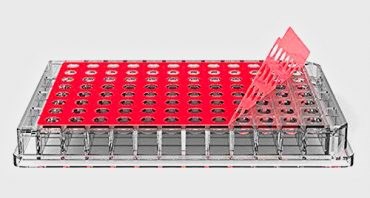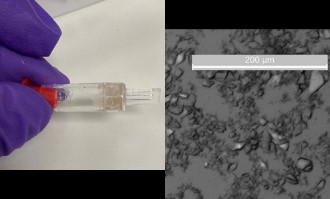Protein crystallography is a valuable biophysical method in modern structural biology. It is used to determine molecular structures of proteins that are paramount to many industrial and medical research programmes, where it plays a role in the development of new medicines, aiding our understanding of new targets and the mode of action associated with new therapeutics. Its success depends on obtaining good quality protein crystals.
SWISSCI, a UK based SME, developed a microdialysis plate for crystallisation and approached NPL to help validate their crystallisation process.
SWISSCI collaborated with scientists from NPL to explore dialysis as an alternative method to pre-established
high-throughput protein crystallography methodologies.
 Using the Diaplate™, a SWISSCI manufactured 96 well high-throughput dialysis plate, the NPL research team demonstrated dialysis as a reliable high-throughput method for macro-molecular crystallisation. This was achieved by successfully crystallising 4 different proteins, including 2 membrane proteins.
Using the Diaplate™, a SWISSCI manufactured 96 well high-throughput dialysis plate, the NPL research team demonstrated dialysis as a reliable high-throughput method for macro-molecular crystallisation. This was achieved by successfully crystallising 4 different proteins, including 2 membrane proteins.
The membrane proteins were shown to crystallise four times faster than alternative techniques and produced high quality crystals. This data suggests that high-throughput dialysis may have distinct advantages over other methods and is very simple to use.
 For all proteins tested, the NPL team were able to grow a high density of microcrystals in certain conditions. Furthermore, the yield of crystals was able to be increased by scaling up the experiment using a higher volume, standalone, SWISSCI manufactured dialysis device, the Diacon™.
For all proteins tested, the NPL team were able to grow a high density of microcrystals in certain conditions. Furthermore, the yield of crystals was able to be increased by scaling up the experiment using a higher volume, standalone, SWISSCI manufactured dialysis device, the Diacon™.
The results of these experiments indicate that dialysis is an effective method for high throughput protein crystallography and can be considered as a viable complementary method to pre-established crystallisation technologies. Initial findings also indicate that it could be a method of choice for producing micro/nano protein crystals for modern data collection methods including serial crystallography at microfocus beamlines / XFEL’s and MicroED. These are noteworthy tools in protein 3D structure determination, and are critical in understanding biology, accomplishing improved drug design and finding new ways to control cell function in the treatment of various illnesses.
Tristan Kwan of NPL, who performed many of the experiments, commented: “Accelerated crystal growth was among some interesting findings and a very welcome surprise. We will employ the technique to expand on the range of crystallisation methods we use in the lab”.
 This work was undertaken as part of the Measurement for Recovery programme.
This work was undertaken as part of the Measurement for Recovery programme.
Many thanks to the team at NPL for the excellent work and superb guidance on this project. The work is of a very high standard and we have already implemented some of the suggestions.
Paul Reardon, Managing Director - SWISSCI
SWISSCI provides scientists with innovative laboratory solutions. Their specialist areas are Crystallography, Cryo EM, Cell Culture, Data Collection, PCR consumables, Dialysis, Instrumentation and other unique moulded solutions. They continue to expand and develop their product range often in collaboration with key technological institutes.